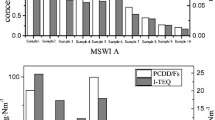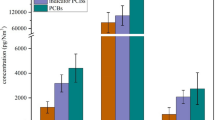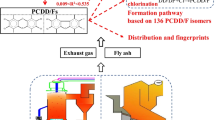Abstract
Electric arc furnaces (EAF) are well recognized as significant sources of dioxins. EAFs have also been speculated to be sources of polychlorinated naphthalenes (PCNs) due to the close correlation between dioxin and PCN formation. However, assessment on PCN emissions from EAFs has not been carried out. The primary aim of this preliminary study is to identify and characterize the atmospheric emission of PCNs from EAFs. In this preliminary study, stack gas samples from two typical EAFs with different scales (EAF-1, 160 t batch−1; and EAF-2, 60 t batch−1) were collected by automatic isokinetic sampling technique, and PCN congeners in samples were analyzed by isotope dilution high-resolution gas chromatography combined with high-resolution mass spectrometry method. Emission concentrations of PCNs were 458 and 1,099 ng m−3 for EAF-1 and EAF-2, respectively. The emission factors of PCNs to air were 21.6 and 30.1 ng toxic equivalent t−1 for EAF-1 and EAF-2, respectively, which suggested that EAF is an important source of PCN release. With regard to the characteristics of PCNs from EAFs, lower chlorinated homologues were dominant. The PCN congeners comprised of CN27/30, CN52/60, CN66/67, and CN73 were the most abundant congeners for tetra-, penta-, hexa-, and hepta-chlorinated homologues, respectively. EAFs were identified to be an important PCN source, and the obtained data are useful for developing a PCN inventory. The congener profiles of PCNs presented here might provide helpful information for identifying the specific sources of PCNs emitted from EAFs.


Similar content being viewed by others
References
Abad E, Caixach J, Rivera J (1999) Dioxin like compounds from municipal waste incinerator emissions: assessment of the presence of polychlorinated naphthalenes. Chemosphere 38:109–120
Ba T, Zheng MH, Zhang B, Liu WB, Su GJ, Liu GR, Xiao K (2010) Estimation and congener-specific characterization of polychlorinated naphthalene emissions from secondary nonferrous metallurgical facilities in China. Environ Sci Technol 44:2441–2446
Bidleman TF, Helm PA, Braune BM, Gabrielsen GW (2010) Polychlorinated naphthalenes in polar environments—a review. Sci Total Environ 408:2919–2935
Blankenship AL, Kannan K, Villalobos SA, Villeneuve DL, Falandysz J, Imagawa T, Jakobsson E, Giesy JP (2000) Relative potencies of individual polychlorinated naphthalenes and halowax mixtures to induce Ah receptor-mediated responses. Environ Sci Technol 34:3153–3158
Du B, Zheng MH, Tian HH, Liu AM, Huang YR, Li LL, Ba T, Li N, Ren Y, Li YW, Dong SP, Su GJ (2010) Occurrence and characteristics of polybrominated dibenzo-p-dioxins and dibenzofurans in stack gas emissions from industrial thermal processes. Chemosphere 80:1227–1233
Fiedler H (2007) National PCDD/PCDF release inventories under the Stockholm convention on persistent organic pollutants. Chemosphere 67:S96–S108
Grochowalski A, Lassen C, Holtzer M, Sadowski M, Hudyma T (2007) Determination of PCDDs, PCDFs, PCBs and HCB emissions from the metallurgical sector in Poland. Environ Sci Pollut Res 14:326–332
Gullett BK, Touati A, Huwe J, Hakk H (2006) PCDD and PCDF emissions from simulated sugarcane field burning. Environ Sci Technol 40:6228–6234
Harner T, Shoeib M, Gouin T, Blanchard P (2006) Polychlorinated naphthalenes in Great Lakes air: assessing spatial trends and combustion inputs using PUF disk passive air samplers. Environ Sci Technol 40:5333–5339
Hogarh JN, Seike N, Kobara Y, Masunaga S (2012) Atmospheric polychlorinated naphthalenes in Ghana. Environ Sci Technol 46(5):2600–2606
Imagawa T, Lee CW (2001) Correlation of polychlorinated naphthalenes with polychlorinated dibenzofurans formed from waste incineration. Chemosphere 44:1511–1520
Jansson S, Fick J, Marklund S (2008) Formation and chlorination of polychlorinated naphthalenes (PCNs) in the post-combustion zone during MSW combustion. Chemosphere 72:1138–1144
Kannan K, Imagawa T, Blankenship AL, Giesy JP (1998) Isomer-specific analysis and toxic evaluation of polychlorinated naphthalenes in soil, sediment, and biota collected near the site of a former chlor-alkali plant. Environ Sci Technol 32:2507–2514
Kannan K, Kober JL, Kang YS, Masunaga S, Nakanishi J, Ostaszewski A, Giesy JP (2001) Polychlorinated naphthalenes, biphenyls, dibenzo-p-dioxins, and dibenzofurans as well as polycyclic aromatic hydrocarbons and alkylphenols in sediment from the Detroit and Rouge Rivers, Michigan, USA. Environ Toxicol Chem 20:1878–1889
Liu GR, Zheng MH, Lv P, Liu WB, Wang CZ, Zhang B, Xiao K (2010) Estimation and characterization of polychlorinated naphthalene emission from coking industries. Environ Sci Technol 44:8156–8161
Meijer SN, Harner T, Helm PA, Halsall CJ, Johnston AE, Jones KC (2001) Polychlorinated naphthalenes in UK soils: time trends, markers of source, and equilibrium status. Environ Sci Technol 35:4205–4213
Nie ZQ, Zheng MH, Liu WB, Zhang B, Liu GR, Su GJ, Lv P, Xiao K (2011) Estimation and characterization of PCDD/Fs, dl-PCBs, PCNs, HxCBz and PeCBz emissions from magnesium metallurgy facilities in China. Chemosphere 85:1707–1712
Noma Y, Yamamoto T, Sakai SI (2004) Congener-specific composition of polychlorinated naphthalenes, coplanar PCBs, dibenzo-p-dioxins, and dibenzofurans in the halowax series. Environ Sci Technol 38:1675–1680
Odabasi M, Bayram A, Elbir T, Seyfioglu R, Dumanoglu Y, Bozlaker A, Demircioglu H, Altiok H, Yatkin S, Cetin B (2009) Electric arc furnaces for steel-making: hot spots for persistent organic pollutants. Environ Sci Technol 43:5205–5211
Park H, Kang JH, Baek SY, Chang YS (2010) Relative importance of polychlorinated naphthalenes compared to dioxins, and polychlorinated biphenyls in human serum from Korea: contribution to TEQs and potential sources. Environ Pollut 158:1420–1427
Schneider M, Stieglitz L, Will R, Zwick G (1998) Formation of polychlorinated naphthalenes on fly ash. Chemosphere 37:2055–2070
Schuhmacher M, Domingo JL (2006) Long-term study of environmental levels of dioxins and furans in the vicinity of a municipal solid waste incinerator. Environ Int 32:397–404
UNEP (2011) UNEP/POPS/POPRC.7/2. http://chm.pops.int/Convention/POPsReviewCommittee/POPRCMeetings/POPRC7/POPRC7Documents/tabid/2267/language/en-US/Default.aspx. Accessed 2 Jan 2012
Weber R, Iino F, Imagawa T, Takeuchi M, Sakurai T, Sadakata M (2001) Formation of PCDF, PCDD, PCB, and PCN in de novo synthesis from PAH: mechanistic aspects and correlation to fluidized bed incinerators. Chemosphere 44:1429–1438
Weber R, Gaus C, Tysklind M, Johnston P, Forter M, Hollert H, Heinisch E, Holoubek I, Lloyd-Smith M, Masunaga S, Moccarelli P, Santillo D, Seike N, Symons R, Torres JPM, Verta M, Varbelow G, Vijgen J, Watson A, Costner P, Woelz J, Wycisk P, Zennegg M (2008) Dioxin- and POP-contaminated sites-contemporary and future relevance and challenges. Environ Sci Pollut Res 15:363–393
Acknowledgments
Financial support for the present work was obtained from the National 973 Program (no. 2009CB421606) and the National Natural Science Foundation of China (nos. 21107123 and 21037003).
Author information
Authors and Affiliations
Corresponding author
Additional information
Responsible editor: Philippe Garrigues
Electronic supplementary material
Below is the link to the electronic supplementary material.
ESM 1
(DOC 74 kb)
Rights and permissions
About this article
Cite this article
Liu, G., Zheng, M., Du, B. et al. Identification and characterization of the atmospheric emission of polychlorinated naphthalenes from electric arc furnaces. Environ Sci Pollut Res 19, 3645–3650 (2012). https://doi.org/10.1007/s11356-012-1038-2
Received:
Accepted:
Published:
Issue Date:
DOI: https://doi.org/10.1007/s11356-012-1038-2




